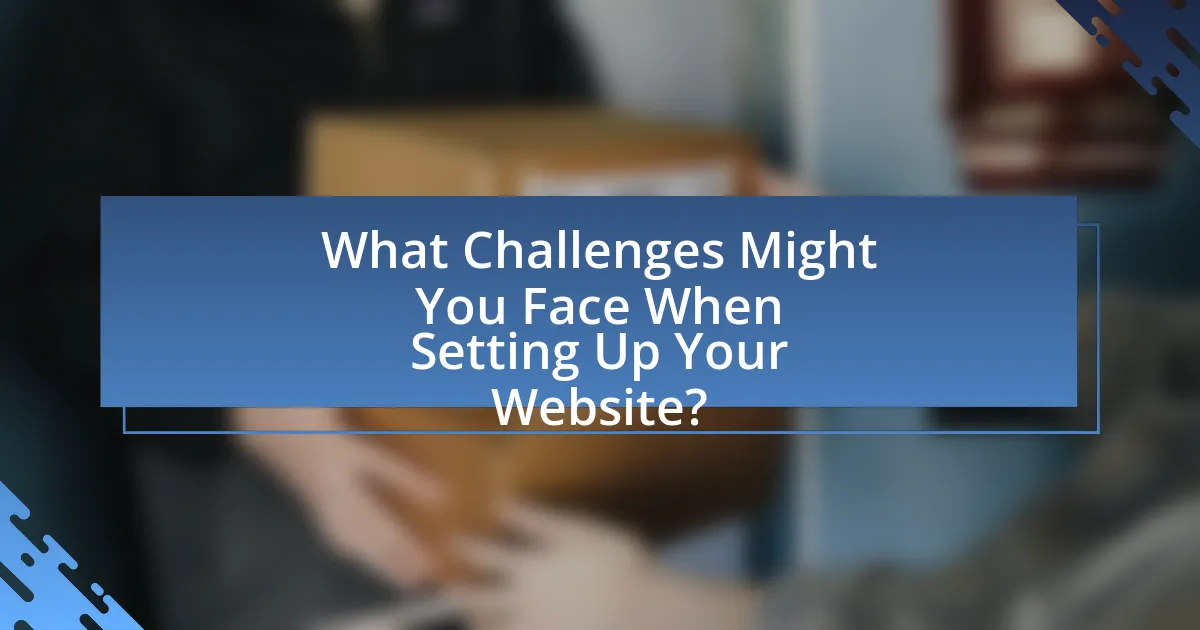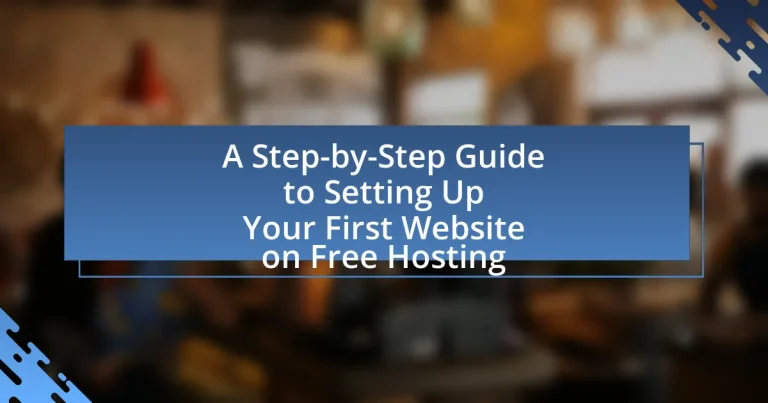The article provides a comprehensive guide on setting up a website using free hosting services. It covers essential steps such as selecting a hosting provider, registering a domain name, and utilizing website builders like WordPress and Wix. Key considerations for choosing a hosting provider, including storage, bandwidth, and customer support, are discussed, along with common challenges and limitations associated with free hosting. The article also outlines best practices for optimizing website performance, enhancing user experience, and maintaining security, ensuring that beginners can effectively establish and manage their online presence.

What is Involved in Setting Up Your First Website on Free Hosting?
Setting up your first website on free hosting involves selecting a free hosting provider, registering for an account, choosing a domain name, and using a website builder or content management system to create your site. Free hosting providers, such as WordPress.com or Wix, offer user-friendly interfaces and templates that simplify the website creation process. After registering, you can customize your site’s design and content, and finally publish it for public access. According to a 2021 survey by Statista, over 40% of websites are built on free platforms, indicating their popularity and accessibility for beginners.
How do you choose the right free hosting provider?
To choose the right free hosting provider, evaluate key factors such as storage space, bandwidth, uptime reliability, and customer support. A provider that offers at least 1 GB of storage and 5 GB of bandwidth is generally sufficient for small websites. Additionally, look for a minimum uptime guarantee of 99.9% to ensure your site remains accessible. Customer support options, including live chat or email, are crucial for resolving issues quickly. Researching user reviews and comparisons can further validate the provider’s reputation and service quality.
What features should you look for in a free hosting service?
When selecting a free hosting service, prioritize features such as storage capacity, bandwidth limits, uptime reliability, customer support, and ease of use. A sufficient storage capacity ensures that your website can accommodate content without frequent upgrades, while generous bandwidth limits prevent slow loading times during traffic spikes. Uptime reliability, ideally above 99.9%, guarantees that your website remains accessible to visitors. Effective customer support, even in free services, can assist with troubleshooting and technical issues. Lastly, an intuitive interface simplifies the website setup process, making it accessible for beginners. These features collectively enhance the functionality and user experience of your website on a free hosting platform.
How do different free hosting providers compare?
Different free hosting providers vary significantly in terms of features, limitations, and user experience. For instance, providers like WordPress.com offer a user-friendly interface and a wide range of themes, but they impose restrictions on custom domain usage and monetization options. In contrast, InfinityFree provides unlimited disk space and bandwidth, making it suitable for users with larger projects, but it lacks customer support and has limited uptime guarantees. Additionally, platforms like Wix and Weebly offer drag-and-drop builders that simplify website creation, yet they often include ads on free plans and restrict storage capacity. These differences highlight the importance of evaluating specific needs, such as storage, support, and customization, when choosing a free hosting provider.
What are the basic steps to set up a website?
To set up a website, follow these basic steps: choose a domain name, select a web hosting service, design your website, and publish it. First, selecting a domain name involves identifying a unique and relevant name that reflects your website’s purpose. Next, choosing a web hosting service is crucial; free hosting options like WordPress.com or Wix provide essential features for beginners. After securing hosting, designing your website can be done using templates or website builders, which simplify the process. Finally, publishing your website makes it accessible online, allowing users to visit your site. These steps are foundational for establishing an online presence effectively.
How do you register a domain name for your website?
To register a domain name for your website, choose a domain registrar, search for your desired domain name, and complete the registration process by providing your information and payment. Domain registrars, such as GoDaddy, Namecheap, and Google Domains, facilitate the registration of domain names by allowing users to check availability and purchase the domain. The registration typically requires personal details like your name, address, and email, along with a payment method to secure the domain for a specified period, usually one year. According to ICANN, the organization that oversees domain registrations, it is essential to ensure that the domain name is unique and not already in use to successfully complete the registration.
What are the steps to link your domain to your hosting provider?
To link your domain to your hosting provider, follow these steps: First, obtain the nameservers from your hosting provider, which are typically found in your account dashboard or welcome email. Next, log in to your domain registrar’s website and navigate to the domain management section. Update the nameserver settings by replacing the existing nameservers with the ones provided by your hosting provider. Save the changes, and allow up to 48 hours for the DNS propagation to complete, during which your domain will become linked to your hosting account. This process is essential for directing web traffic to your website hosted on the server.
What tools and platforms can you use to build your website?
To build your website, you can use tools and platforms such as WordPress, Wix, Squarespace, and Weebly. WordPress powers over 40% of all websites globally, making it a highly popular choice due to its flexibility and extensive plugin ecosystem. Wix offers an intuitive drag-and-drop interface, allowing users to create visually appealing sites without coding knowledge. Squarespace is known for its design-oriented templates, catering to creatives and businesses seeking a polished online presence. Weebly provides an easy-to-use platform with e-commerce capabilities, making it suitable for small businesses. Each of these platforms offers unique features that cater to different user needs, ensuring a variety of options for website creation.
What are the most popular website builders available for free hosting?
The most popular website builders available for free hosting include Wix, Weebly, WordPress.com, and Google Sites. Wix offers a user-friendly drag-and-drop interface and a variety of templates, making it suitable for beginners. Weebly provides similar features with a focus on e-commerce capabilities. WordPress.com is widely recognized for its extensive customization options and a large community of users. Google Sites allows for easy integration with other Google services, making it a convenient choice for those already using Google products. These platforms are widely used due to their accessibility and range of features, catering to different user needs.
How do you choose the right content management system (CMS)?
To choose the right content management system (CMS), evaluate your specific needs, including ease of use, scalability, and available features. A CMS like WordPress is user-friendly and offers extensive plugins, making it suitable for beginners, while platforms like Drupal provide advanced customization for more complex sites. According to W3Techs, WordPress powers over 40% of all websites, indicating its popularity and reliability. Additionally, consider the community support and documentation available, as these resources can significantly aid in troubleshooting and development.

What Challenges Might You Face When Setting Up Your Website?
When setting up your website, you may face challenges such as limited storage and bandwidth, which can restrict your site’s performance and scalability. Free hosting services often impose these limitations, making it difficult to accommodate high traffic or large files. Additionally, you might encounter difficulties with customization options, as many free hosting platforms offer restricted templates and features, hindering your ability to create a unique design. Security concerns also arise, as free hosting providers may not offer robust security measures, leaving your site vulnerable to attacks. Furthermore, technical support can be minimal or non-existent, complicating troubleshooting and maintenance. These challenges are common among users of free hosting services, as highlighted by various user reviews and industry analyses.
How can you troubleshoot common issues during setup?
To troubleshoot common issues during setup, first identify the specific problem, such as connectivity issues, configuration errors, or software incompatibility. For instance, if the website does not load, check the internet connection and ensure that the hosting service is active. Additionally, verify that all necessary files are uploaded correctly and that the domain settings are configured properly. According to a survey by W3Techs, 40% of websites experience downtime due to misconfigurations, highlighting the importance of double-checking settings. If error messages appear, consult the documentation or support forums for the hosting service, as they often provide solutions for common errors encountered during setup.
What are the most frequent problems encountered with free hosting?
The most frequent problems encountered with free hosting include limited storage and bandwidth, lack of customer support, and frequent downtime. Limited storage and bandwidth restrict the amount of data and traffic a website can handle, often leading to slow performance or site crashes. Lack of customer support means users may struggle to resolve issues promptly, impacting website functionality. Frequent downtime can result from shared server resources, causing websites to be unavailable at critical times. These issues are commonly reported by users of free hosting services, highlighting the trade-offs associated with no-cost options.
How can you resolve domain linking issues?
To resolve domain linking issues, first ensure that the domain’s DNS settings are correctly configured to point to the hosting provider’s nameservers. This involves accessing the domain registrar’s control panel and updating the nameserver records to match those provided by the hosting service. Additionally, verify that the domain is properly registered and not expired, as an expired domain can lead to linking issues. According to ICANN, proper DNS configuration is crucial for domain resolution, as incorrect settings can prevent users from accessing the website.
What limitations should you be aware of with free hosting?
Free hosting typically comes with several limitations that users should be aware of. These limitations often include restricted bandwidth, which can lead to slow loading times and potential downtime during high traffic periods. Additionally, free hosting services frequently impose storage limits, which can hinder the ability to upload large files or host extensive content. Users may also face a lack of customer support, making it difficult to resolve issues promptly. Furthermore, free hosting often includes mandatory advertisements, which can detract from the user experience and the professional appearance of the website. Lastly, users may have limited control over their domain name, often resulting in subdomains that can affect branding and credibility.
How does bandwidth affect your website’s performance?
Bandwidth directly affects a website’s performance by determining the amount of data that can be transmitted between the server and users within a given time frame. Higher bandwidth allows for faster loading times and smoother user experiences, as it can accommodate more simultaneous visitors and larger files without delays. For instance, a website with a bandwidth of 100 Mbps can handle more data transfer compared to one with only 10 Mbps, leading to quicker page loads and reduced buffering for multimedia content. Studies have shown that a one-second delay in page load time can lead to a 7% reduction in conversions, highlighting the critical role bandwidth plays in user engagement and satisfaction.
What are the implications of limited storage on your website?
Limited storage on your website can lead to performance issues, restricted content uploads, and potential downtime. When storage is insufficient, website owners may experience slow loading times, which negatively impacts user experience and can lead to higher bounce rates. Additionally, limited storage restricts the ability to upload images, videos, and other media, limiting the website’s functionality and appeal. According to a study by Google, 53% of mobile site visitors abandon a page that takes longer than three seconds to load, highlighting the importance of adequate storage for maintaining user engagement. Furthermore, if storage limits are reached, the website may become inaccessible, resulting in lost traffic and potential revenue.

What Best Practices Should You Follow for Your First Website?
To create your first website effectively, follow best practices such as selecting a user-friendly platform, ensuring mobile responsiveness, and optimizing for search engines. A user-friendly platform like WordPress or Wix simplifies the design process, making it accessible for beginners. Mobile responsiveness is crucial, as over 50% of web traffic comes from mobile devices, according to Statista. Additionally, optimizing for search engines through proper use of keywords and meta tags enhances visibility, with 93% of online experiences beginning with a search engine, as reported by Search Engine Journal. These practices collectively contribute to a successful website launch.
How can you optimize your website for better performance?
To optimize your website for better performance, focus on reducing load times and improving user experience. Implement techniques such as image compression, which can decrease file sizes by up to 70% without significant loss of quality, thus speeding up page loading. Utilize browser caching to store frequently accessed resources, which can reduce server requests and improve load times by 50% or more. Additionally, minimize HTTP requests by combining CSS and JavaScript files, which can lead to faster rendering times. According to Google, optimizing these elements can enhance your website’s performance score, leading to better search engine rankings and increased user engagement.
What are effective strategies for improving loading speed?
Effective strategies for improving loading speed include optimizing images, minimizing HTTP requests, and leveraging browser caching. Optimizing images involves compressing them without sacrificing quality, which can significantly reduce load times; for instance, using formats like WebP can decrease image size by up to 30% compared to JPEG. Minimizing HTTP requests can be achieved by combining CSS and JavaScript files, which reduces the number of requests the server must handle, thus speeding up loading. Leveraging browser caching allows frequently accessed resources to be stored locally on a user’s device, reducing the need to fetch them from the server repeatedly, which can improve loading speed by up to 80% for returning visitors.
How can you enhance user experience on your website?
To enhance user experience on your website, prioritize fast loading times, intuitive navigation, and mobile responsiveness. Fast loading times improve user retention; studies show that a one-second delay can reduce conversions by 7%. Intuitive navigation allows users to find information quickly, which is crucial as 94% of users cite easy navigation as a key factor in their online experience. Mobile responsiveness ensures that your website functions well on various devices, with over 50% of global web traffic coming from mobile devices. Implementing these strategies will significantly improve user satisfaction and engagement on your website.
What are some tips for maintaining your website after setup?
To maintain your website after setup, regularly update your content, monitor website performance, and ensure security measures are in place. Regular content updates keep your site relevant and engaging, which can improve search engine rankings. Monitoring performance through tools like Google Analytics helps identify issues such as slow loading times or high bounce rates, allowing for timely adjustments. Implementing security measures, such as using strong passwords and keeping software up to date, protects your site from vulnerabilities and cyber threats. These practices are essential for sustaining a functional and secure website.
How often should you update your website content?
You should update your website content at least every few months to maintain relevance and improve SEO performance. Regular updates signal to search engines that your site is active, which can enhance your rankings. According to a study by HubSpot, websites that regularly publish fresh content receive 55% more visitors than those that do not. Additionally, updating content can help engage your audience and encourage return visits, as users are more likely to return to a site that offers new information or insights.
What security measures should you implement for your website?
To secure your website, implement measures such as using HTTPS, regularly updating software, employing strong passwords, and utilizing a web application firewall. HTTPS encrypts data between the user and the server, protecting sensitive information. Regular software updates patch vulnerabilities, reducing the risk of exploitation. Strong passwords prevent unauthorized access, while a web application firewall filters and monitors HTTP traffic, blocking malicious requests. According to a 2021 report by Verizon, 43% of data breaches involve web applications, highlighting the importance of these security measures.
What common mistakes should you avoid when using free hosting?
When using free hosting, you should avoid common mistakes such as neglecting to read the terms of service, which can lead to unexpected limitations or restrictions. Many free hosting providers impose bandwidth and storage limits that can hinder your website’s performance. Additionally, failing to back up your data regularly can result in loss if the hosting service shuts down or experiences issues. Not optimizing your website for speed and performance can also lead to poor user experience, as free hosting often has slower server response times. Lastly, overlooking the importance of security measures can expose your website to vulnerabilities, as free hosting services may not provide adequate protection against cyber threats.
How can you prevent your website from going offline?
To prevent your website from going offline, ensure you choose a reliable hosting provider with a strong uptime guarantee, ideally above 99.9%. Reliable hosting services, such as those from companies like Bluehost or SiteGround, often provide robust infrastructure and support that minimize downtime. Additionally, regularly back up your website data and implement a content delivery network (CDN) to distribute traffic and reduce server load, which further enhances availability. According to a study by the Uptime Institute, 70% of downtime incidents are preventable with proper infrastructure and maintenance, reinforcing the importance of these strategies.
What are the risks of using too many plugins or themes?
Using too many plugins or themes can lead to significant risks, including decreased website performance, increased security vulnerabilities, and potential compatibility issues. Each additional plugin or theme adds code that can slow down loading times, negatively impacting user experience and search engine rankings. According to a study by Google, a one-second delay in page load time can lead to a 20% decrease in conversions. Furthermore, plugins and themes can introduce security flaws; a report from Sucuri found that 90% of hacked websites had vulnerabilities in plugins. Lastly, compatibility issues may arise when multiple plugins or themes conflict with each other, leading to site crashes or malfunctions, which can disrupt service and frustrate users.


